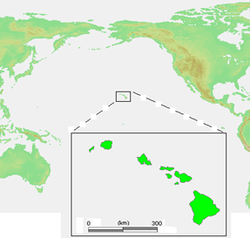Kingdom of Hawaii
| Kingdom of Hawaiʻi | ||||||||||||||
| Aupuni Mōʻī o Hawaiʻi | ||||||||||||||
|
||||||||||||||
|
||||||||||||||
Motto
|
||||||||||||||
Anthem
|
||||||||||||||
|
Kingdom of Hawaii
|
||||||||||||||
| Capital | ||||||||||||||
| Languages | Hawaiian, English | |||||||||||||
| Religion | Church of Hawaii | |||||||||||||
| Government |
|
|||||||||||||
| Monarch | ||||||||||||||
| • | 1795–1819 | Kamehameha I (first) | ||||||||||||
| • | 1891–1893 | Liliʻuokalani (last) | ||||||||||||
| Kuhina Nui | ||||||||||||||
| • | 1819–1832 | Kaʻahumanu I (first) | ||||||||||||
| • | 1863–1864 | Kekūanāoʻa (last) | ||||||||||||
| Legislature | Legislature | |||||||||||||
| • | Upper house | House of Nobles | ||||||||||||
| • | Lower house | House of Representatives | ||||||||||||
| History | ||||||||||||||
| • | Inception | May, 1795 | ||||||||||||
| • | Unification | March/April 1810 | ||||||||||||
| • | Constitutional monarchy | October 8, 1840 | ||||||||||||
| • | Occupation by Great Britain | February 25 – July 31, 1843 | ||||||||||||
| • | Anglo-Franco Proclamation | November 28, 1843 | ||||||||||||
| • | Monarchy overthrown | January 17, 1893 | ||||||||||||
| • | Defunct | January 24, 1895 | ||||||||||||
| Population | ||||||||||||||
| • | 1800 est. | 250,000 | ||||||||||||
| • | 1832 est. | 130,313 | ||||||||||||
| • | 1890 est. | 89,990 | ||||||||||||
| Currency | ||||||||||||||
|
||||||||||||||
| Today part of | ||||||||||||||
The Kingdom of Hawaii was established in 1795 with the unification of the independent islands of Hawaiʻi, Oʻahu, Maui, Molokaʻi, and Lānaʻi into one government. In 1810 the entirety of the archipelago was unified when Kauaʻi and Niʻihau joined the kingdom willingly and without bloodshed or war. The kingdom was ruled by two major dynastic families: the House of Kamehameha and the House of Kalākaua.
The kingdom won recognition from major European powers. The United States became its chief trading partner, and the kingdom was watched jealously lest Britain, Japan or another power threatened to seize control. A new Constitution was imposed in 1887, to reduce the absolute power of the king. The queen who succeeded him tried to restore the old order, but was overthrown in 1893, largely at the hands of United States citizens. Hawaii became a republic until it was annexed by the United States in 1898.
Economic and demographic factors in the 19th century reshaped the islands. In 1848 the Great Māhele was imposed by the king; it resulted in the selling off virtually all the village land farmed by the natives. For the natives, contact with the outer world represented demographic disaster, as a series of unfamiliar diseases such as smallpox decimated the natives. The Hawaiian population of natives fell from approximately 128,000 in 1778 to 71,000 in 1853, and kept declining to 24,000 in 1920. Most lived in remote villages.
...
Wikipedia




